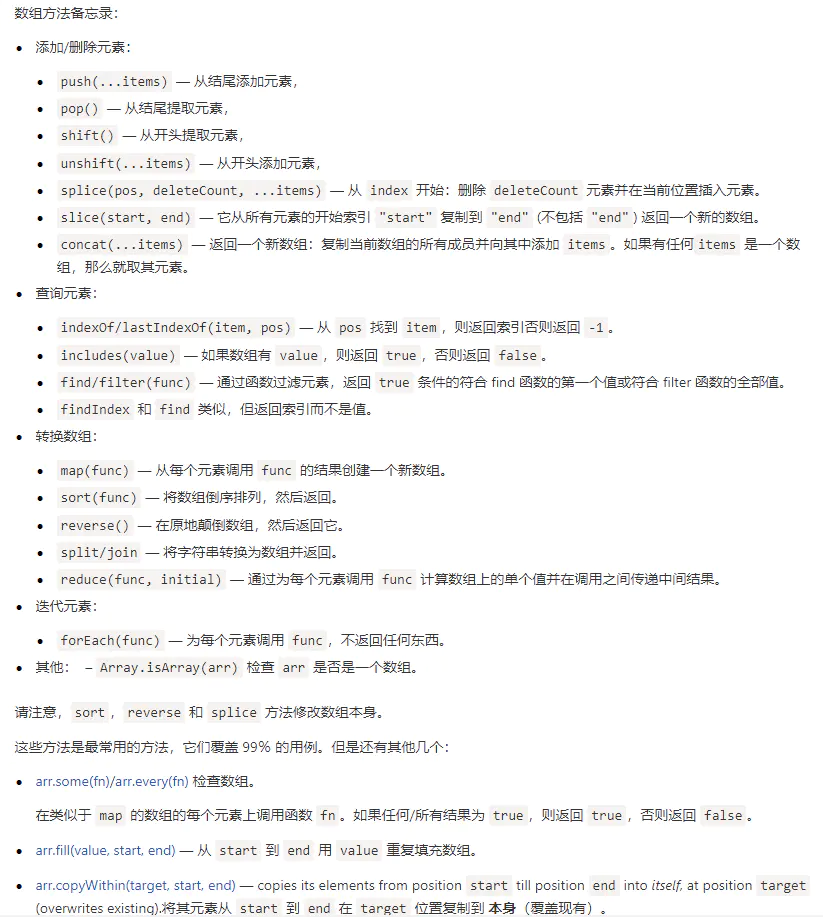JS数组技巧
Posted rachelch
tags:
篇首语:本文由小常识网(cha138.com)小编为大家整理,主要介绍了JS数组技巧相关的知识,希望对你有一定的参考价值。
数组常用方法:

数组解构赋值应用
// 交换变量 [a, b] = [b, a] [o.a, o.b] = [o.b, o.a] // 生成剩余数组 const [a, ...rest] = [...‘asdf‘] // a:‘a‘,rest: ["s", "d", "f"]
数组浅拷贝
const arr = [1, 2, 3] const arrClone = [...arr] // 对象也可以这样浅拷贝 const obj = { a: 1 } const objClone = { ...obj }
数组合并
const arr1 = [1, 2, 3] const arr2 = [4, 5, 6] const arr3 = [7, 8, 9] const arr = [...arr1, ...arr2, ...arr3]
数组去重
const arr = [1, 1, 2, 2, 3, 4, 5, 5] const newArr = [...new Set(arr)]
new Set(arr) 接受一个数组参数并生成一个 set 结构的数据类型。set 数据类型的元素不会重复且是 Array Iterator,所以可以利用这个特性来去重
数组取交集
const a = [0, 1, 2, 3, 4, 5] const b = [3, 4, 5, 6, 7, 8] const duplicatedValues = [...new Set(a)].filter(item => b.includes(item)) duplicatedValues // [3, 4, 5]
数组取差集
const a = [0, 1, 2, 3, 4, 5] const b = [3, 4, 5, 6, 7, 8] const diffValues = [...new Set([...a, ...b])].filter(item => !b.includes(item) || !a.includes(item)) // [0, 1, 2, 6, 7, 8]
数组转对象
const arr = [1, 2, 3, 4] const newObj = {...arr} // {0: 1, 1: 2, 2: 3, 3: 4} const obj = {0: 0, 1: 1, 2: 2, length: 3} // 对象转数组不能用展开操作符,因为展开操作符必须用在可迭代对象上 let newArr = [...obj] // Uncaught TypeError: object is not iterable... // 可以使用Array.form()将类数组对象转为数组 let newArr = Array.from(obj) // [0, 1, 2]
数组常用遍历
数组常用遍历有 forEach、every、some、filter、map、reduce、reduceRight、find、findIndex 等方法,很多方法都可以达到同样的效果。数组方法不仅要会用,而且要用好。要用好就要知道什么时候用什么方法。
遍历的混合使用
filter、map 法返回值仍旧是一个数组,所以可以搭配其他数组遍历方法混合使用。注意遍历越多效率越低~
const arr = [1, 2, 3, 4, 5] const value = arr .map(item => item * 3) .filter(item => item % 2 === 0) .map(item => item + 1) .reduce((prev, curr) => prev + curr, 0)
检测数组所有元素是否都符合判断条件
const arr = [1, 2, 3, 4, 5] const isAllNum = arr.every(item => typeof item === ‘number‘)
检测数组是否有元素符合判断条件
const arr = [1, 2, 3, 4, 5] const hasNum = arr.some(item => typeof item === ‘number‘)
找到第一个符合条件的元素/下标
const arr = [1, 2, 3, 4, 5] const findItem = arr.find(item => item === 3) // 返回子项 const findIndex = arr.findIndex(item => item === 3) // 返回子项的下标 // 我以后再也不想看见下面这样的代码了?? let findIndex arr.find((item, index) => { if (item === 3) { findIndex = index } })
数组使用误区
数组的方法很多,很多方法都可以达到同样的效果,所以在使用时要根据需求使用合适的方法。
垃圾代码产生的很大原因就是数组常用方法使用不当,这里有以下需要注意的点:
array.includes() 和 array.indexOf()
array.includes() 返回布尔值,array.indexOf() 返回数组子项的索引。indexof 一定要在需要索引值的情况下使用。
const arr = [1, 2, 3, 4, 5] // 使用indexOf,需要用到索引值 const index = arr.indexOf(1) // 0 if (~index) { // 若index === -1,~index得到0,判断不成立;若index不为-1,则~index得到非0,判断成立。 arr.spilce(index, 1) } // 使用includes,不需要用到索引值 // 此时若用indexOf会造成上下文上的阅读负担:到底其他地方有没有用到这个index? const isExist = arr.includes(6) // true if (!isExist) { arr.push(6) }
【注意】array.indexOf() 找 NaN 会找不到,返回 -1,array.includes() 能找到,返回 true~
[NaN].includes(NaN) // true [NaN].indexOf(NaN) // -1
array.find() 、 array.findIndex() 和 array.some()
array.find() 返回值是第一个符合条件的数组子项,array.findIndex() 返回第一个符合条件的数组子项的下标,array.some() 返回有无复合条件的子项,如有返回 true,若无返回 false。注意这三个都是短路操作,即找到符合条件的之后就不在继续遍历。
在需要数组的子项的时候使用 array.find() ;需要子项的索引值的时候使用 array.findIndex() ;而若只需要知道有无符合条件的子项,则用 array.some() 。
const arr = [{label: ‘男‘, value: 0}, {label: ‘女‘, value: 1}, {label: ‘不男不女‘, value: 2}]
// 使用some
const isExist = arr.some(item => item.value === 2)
if (isExist) {
console.log(‘哈哈哈找到了‘)
}
// 使用find
const item = arr.find(item => item.value === 2)
if (item) {
console.log(item.label)
}
// 使用findIndex
const index = arr.findIndex(item => item.value === 2)
if (index) {
const delItem = arr[index]
arr.splice(index, 1)
console.log(`你删除了${delItem.label}`)
}
【建议】在只需要布尔值的时候和数组子项是字符串或数字的时候使用 array.some() :
// 当子包含数字0的时候可能出错 const arr = [0, 1, 2, 3, 4] // 正确 const isExist = arr.some(item => item === 0) if (isExist) { console.log(‘存在要找的子项,很舒服~‘) } // 错误 const isExist = arr.find(item => item === 0) if (isExist) { // isExist此时是0,隐式转换为布尔值后是false console.log(‘执行不到这里~‘) } // 当子项包含空字符串的时候也可能出错 const arr = [‘‘, ‘asdf‘, ‘qwer‘, ‘...‘] // 正确 const isExist = arr.some(item => item === ‘‘) if (isExist) { console.log(‘存在要找的子项,很舒服~‘) } // 错误 const isExist = arr.find(item => item === ‘‘) if (isExist) { // isExist此时是‘‘,隐式转换为布尔值后是false console.log(‘执行不到这里~‘) }
array.find() 和 array.filter()
只需要知道 array.filter() 返回的是所有符合条件的子项组成的数组,会遍历所有数组;而 array.find() 只返回第一个符合条件的子项,是短路操作。以上是关于JS数组技巧的主要内容,如果未能解决你的问题,请参考以下文章